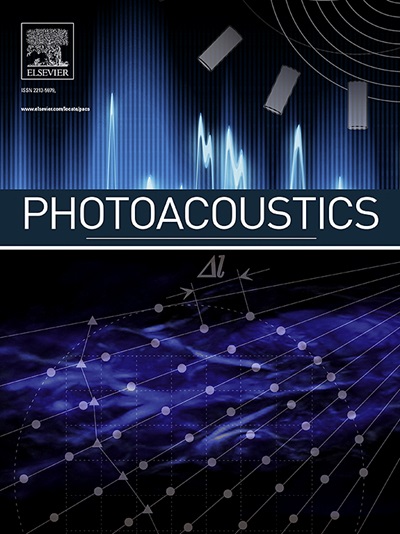Multimodal fluorescence-optoacoustic in vivo imaging of the near-infrared calcium ion indicator NIR-GECO2G
IF 6.8
1区 医学
Q1 ENGINEERING, BIOMEDICAL
引用次数: 0
Abstract
Measuring whole-brain distributed functional activity is an important unmet need in neuroscience, requiring high temporal resolution and cellular specificity across large volumes. Functional optoacoustic neuro-tomography (FONT) with genetically encoded calcium ion indicators is a promising approach towards this goal. However, it has not yet been applied in the near-infrared (NIR) range that provides deep penetration and low vascular background optimal for in vivo neuroimaging. Here, we study the noninvasive multimodal fluorescence and optoacoustic imaging performance of state-of-the-art NIR calcium ion indicator NIR-GECO2G in the mouse brain. We observe robust in vivo signals with widefield fluorescence, and for the first time, with FONT. We also show that in both modalities, the NIR-GECO2G signal improves more than twofold in the biliverdin-enriched Blvra-/- mouse line compared to wild type. Our findings demonstrate the potential of multimodal fluorescence and optoacoustic NIR imaging, opening new possibilities for whole-brain real-time functional imaging in rodents.
近红外钙离子指示剂NIR-GECO2G的多模态荧光光声体内成像。
测量全脑分布式功能活动是神经科学领域尚未满足的一个重要需求,它要求在大容量范围内具有高时间分辨率和细胞特异性。利用基因编码的钙离子指示剂进行功能性光声神经断层成像(FONT)是实现这一目标的一种很有前景的方法。然而,该技术尚未应用于近红外(NIR)范围,而近红外(NIR)范围具有深穿透性和低血管背景,是体内神经成像的最佳选择。在这里,我们研究了最先进的近红外钙离子指示剂 NIR-GECO2G 在小鼠大脑中的无创多模荧光和光声成像性能。我们用宽场荧光观察到了强大的体内信号,并首次用 FONT 观察到了信号。我们还发现,在这两种模式下,富含胆绿素的 Blvra -/- 小鼠系的近红外-GECO2G 信号比野生型提高了两倍多。我们的研究结果证明了多模式荧光和光声近红外成像的潜力,为啮齿类动物全脑实时功能成像开辟了新的可能性。
本文章由计算机程序翻译,如有差异,请以英文原文为准。
求助全文
约1分钟内获得全文
求助全文
来源期刊

Photoacoustics
Physics and Astronomy-Atomic and Molecular Physics, and Optics
CiteScore
11.40
自引率
16.50%
发文量
96
审稿时长
53 days
期刊介绍:
The open access Photoacoustics journal (PACS) aims to publish original research and review contributions in the field of photoacoustics-optoacoustics-thermoacoustics. This field utilizes acoustical and ultrasonic phenomena excited by electromagnetic radiation for the detection, visualization, and characterization of various materials and biological tissues, including living organisms.
Recent advancements in laser technologies, ultrasound detection approaches, inverse theory, and fast reconstruction algorithms have greatly supported the rapid progress in this field. The unique contrast provided by molecular absorption in photoacoustic-optoacoustic-thermoacoustic methods has allowed for addressing unmet biological and medical needs such as pre-clinical research, clinical imaging of vasculature, tissue and disease physiology, drug efficacy, surgery guidance, and therapy monitoring.
Applications of this field encompass a wide range of medical imaging and sensing applications, including cancer, vascular diseases, brain neurophysiology, ophthalmology, and diabetes. Moreover, photoacoustics-optoacoustics-thermoacoustics is a multidisciplinary field, with contributions from chemistry and nanotechnology, where novel materials such as biodegradable nanoparticles, organic dyes, targeted agents, theranostic probes, and genetically expressed markers are being actively developed.
These advanced materials have significantly improved the signal-to-noise ratio and tissue contrast in photoacoustic methods.
 求助内容:
求助内容: 应助结果提醒方式:
应助结果提醒方式:


